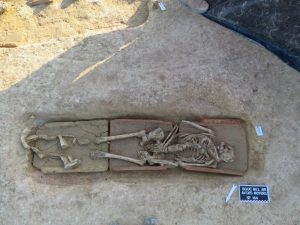Over 300 graves of of various types were discovered by archaeologists in a necropolis dated to late Antiquity, found at Bouc-Bel-Air in southern France.

The excavations were conducted prior to construction of housing estates. Archaeological investigation revealed Neolithic sites and a vast necropolis used in late Antiquity. The earlier, Stone Age features, dating from (10000-3000 BC) consisted of rows of holes, being remnants of wooden structures, and small pits containing pottery and stone tools. The necropolis contained 315 graves with a great variety of registered funerary practices.

According to the researchers, the burial ground was used in the late Antiquity just before Medieval times. Most of the found graves were covered with ceramic tiles, others consisted of wooden or lead coffins. A number of burials within amphorae and jars were also found. Archaeologists state that they also discovered objects indicating pagan rituals, which indicates that Christianity was adapted by the population but very slowly.

Offerings include lamps, coins and small vases, but they slowly disappeared from the graves as burials became progressively Christian. Further analysis of the skeletons, in order to establish more details about the individuals, such as causes of death, health, and diets, are scheduled.

(after International Business Times, Bernard Sillano, Sylvie Mathie & Catherine Rigeade)